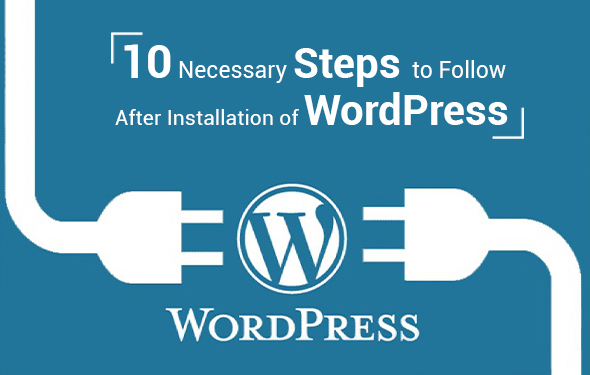10 Necessary Steps to Follow After Installation of WordPress

Of them, WordPress has gained enormous popularity as one of the effective blogging stages. Its popularity only marks its power and contributes to the advertising aspect largely. One of the most basic and essential segments of the internet, WordPress has transformed into a significant segment of the internet powering about 27% of all websites. Create and customize your website with the adept assistance of its technical support considering the factors that suit the website best. Furthermore, with CMS or Content Management System facilities, WordPress caters to the online development initiative of the business. Regardless of the enterprise scale, WordPress offers the ability to alter, edit, modify and transform the content of the website in a manner which is the most convenient.
There are plenty of reasons which make entrepreneurs opt for WordPress and consider it the best choice. While there are ample sophisticated benefits, flexibility, customization, expandability are the key factors which lure the several business owners to this CMS platform. Therefore, incorporate such strong and advanced practices through the mightiest platforms of this era of extreme globalization. However, there are several important steps after you have installed WordPress to make its advanced functions effective.
10 Mandatory Steps You Need to Follow After the Installation of WordPress:
You may plan to start a blog. But, how? Merely installing WordPress doesn’t solve and serve anything productive. The moment after the installation involves innumerable activities which are essential for making the CMS effective. Making these basic and important fixings ,as well as changes, prepare it for exceptional performance. After preparing the settings, you can begin with writing and publishing your blog. Hence, make sure to adhere to the underlying 10 steps to do after installing WordPress.
-
Insert a Contact Form
On the internet, each and every website requires a contact form. This enables the visitors into the website to contact the authorized body of the company by filling out a form. However, WordPress does not arrive with an integrated contact form by default. Hence, the WPForms comes to the rescue. The WPForms is simply the best and the most impressive contact form plugin which enables the users to create and build contact forms for websites conveniently. In case you do not desire to go for this alternative, make an attempt with the free version that it offers. One can download it from the plugin repository of the WordPress.org.
Approximately, 45% of users tend to leave the site in case they find no information by which they can contact the website authorities. This is one of the basic elements that are mandatory to insert into a website which offers the visitors the chance to get in touch with the authorities. Furthermore, it provides the opportunity to develop a network of followers as well as maintain the engagement levels with your content. Thereby, it enhances the overall ranking of the website.
-
Alter Site Tagline, Title, and Timezone
The website taglines and titles bear the purpose of informing the users as well as search engines regarding the website content. For this, one must set up and arrange those components in the General Settings by adding and inserting a general title of the website along with a short description. Make sure to change the time zone settings as well. Firstly, head to the Settings after which you must proceed to the General page. Then, check the fields and change every setting.
-
Setup WordPress SEO
Now, the next thing that you must think about is how to bring the website in front of the public. Yes, merely creating the blog doesn’t yield much difference. For promoting the services of a company, or reaching a huge audience to portray one’s ideas, an expert SEO is a must. However, the CMS, WordPress itself is extremely Search Engine Optimization-friendly. Note that the most convenient time to set up the SEO of the website is right after the installation of WordPress. A common recommendation is to employ the Yoast SEO plugin which is one of the most comprehensive plugins in the market for WordPress SEO. Furthermore, it serves all the significant settings of SEO out of the box.
-
Install Google Analytics
It is essential to understand and know your audience and spectators. The factors like what they search, how you can assist them to find what they seek are necessary to consider. Such insights tend to make wiser decisions which eventually help in the development of the organization. For such things, you require a proper and reliable analytics service like Google Analytics. This presents you the data regarding how many people have visited and accessed your website. Also, it assesses the information regarding where they channeled from as well as the activities that they conducted on the website. Thus, you can monitor the performance of the website. It is the only method to track the consequences and outcome regarding the need for change.
-
Delete Default Content
The CMS, WordPress exhibits a few chunks of default content only to avoid leaving the entire website completely blank. However, in case you launch the website once, there remains no reason for such content to exist. For this, just open the section of the Posts in the Dashboard and proceed to delete the default content like ‘Hello World’. Now, this has the capacity to prove the fact that the authority keeps the website up-to-date. Moving on, click on the link that says Trash. After that, head to pages and then to All Pages only to eliminate and remove the Sample Page. Finally, proceed to the Comments page after which you must delete and remove the default comment.
-
Setup WordPress Comments
One of the tricks to keep the users engaged is by introducing the WordPress comments. Offer a way to make them heard and let them know that their views and opinions matter and such indulgence of the users makes them aware of their development as well. It is always a positive aspect which showcases the company or individual’s respect for their users’ perceptions. Hence, set up WordPress comments which grants them some extra exposure. At times, even other visitors tend to comment and find a separate person’s views interesting which triggers a conversation regarding the matter. Such discourse provides useful insights to the entrepreneur and can potentially benefit you in the future.
10 Necessary Steps to Follow After Installation of WordPress
Furthermore, WordPress comments boost user engagement into the website which ultimately lowers the bounce rate largely. Such user indulgence helps you to build and create a community around your content. For this, head to the Settings and then to the Discussions page in order to set up the comments. Henceforth, you can disable or enable the comments, enable comment moderation, and set up comment notification.
-
Install Plugins and Delete Unused Plugins
Plugins make the CMS software, WordPress powerful, of course. Now, the moment you install WordPress, it is a wise step to do the same with selected significant plugins. The most vital tools are related to SEO, spamming protection, caching, design and security. However, you can use diverse other plugins which drastically enhance the performance of the website.
Regarding the unused pages, it is mandatory for the removal of anything obsolete from the website. Anything outdated is actually a major threat to the website itself. Hence, it is vital to eliminate those plugins that you don’t use anymore for preventing probable problems. Furthermore, the obsolete and unused WordPress tools, at times, enable cybercriminals to invade websites making way for them to exploit the loopholes.
-
Automate Backups
Another important factor for WordPress is the backup system which provides you an opportunity to restore the system whenever a compromising situation takes place. However, the most convenient thing one can do is to automate the backup operation for the proper functioning of the overall performance. A sudden crisis requires a system which tends to hold essential data, information, and records for future reference as well as the present. But, make sure to rely on only authentic and reliable automated tools. According to a survey, about 70% of WordPress installations are susceptible to loopholes which are easy to exploit. Such vulnerabilities can be easily detected using automated tools which have a free version. For this, you must be alert and anticipate manual backups from disrupting the online business.
Each year innumerable damages have incurred losses of data which are roughly worth of millions of dollars. Forming backups is the only convenient method to ensure that the users can easily recover the essential data and information form the website during cases of crisis. Make sure to employ the best and reliable alternative since regular ones are not a viable option.
-
Install Caching
According to reliable studies, even a second delay in loading the page tends to result in a percentage of loss. Most users tend to deviate from the website if the loading time is even 4 seconds long. This increases the bounce rate thereby eventually affecting the organizational sales. Customer satisfaction comes down to zero as well as the page view too. From the plenty of significant factors that helps to rank the website and increase the conversion, the webpage maintenance is a relevant factor. Any entrepreneur must be inclined on updating the site makes sure to cater to the loading time as well as the responsiveness of the website. This is where the importance of caching enters. It allows the website to serve cached copies quickly of your pages to visitors in place of producing them on the fly. Also, this diminishes the server load on the website as well as improve the pace of the loading of the page.
-
Setup WordPress Security
When security is the main concern, WordPress manages it all. Yes, this CMS is known for its distinctiveness and uniqueness in every field. Also, its security standard is very high in comparison to other CMS platform. But, it is mandatory to follow the best practices for maintaining proper security of a website. Few practices are extremely easy like securing WordPress admin area, employing strong passwords and installing updates. However, for other aspects, a plugin is a necessity and make sure to use only a reliable one and caters to vulnerability scanning, website security and malware protection. Ensure to employ one which offers sophisticated WordPress firewall plugin since it hinders suspicious traffic and keeps them from reaching the website.
Lastly
WordPress is a wise alternative as a promising CMS platform where entrepreneurs and business individuals can exhibit and proclaim their services. The already-engaged audience present there can convey the content to other fellow users through the Share option. Also, the comment space can lead to further conversations between unknown visitors which can increase the engagement capability of the website. Convey your ideas through a popular, viable and fertile platform which eventually impacts your sales and brand awareness in a positive manner.
Frequently Asked Questions
10 Necessary Steps to Follow After Installation of WordPress
-
How to install WordPress on your website?
The process of installation of WordPress is extremely easy. Firstly, head to the official website: WordPress.org. Then, proceed to upload the files to the server by employing FTP. After that, create a database as well as a user of MySQL for WordPress. Then, proceed to configure WordPress in order to connect to the freshly formed database. Finally, make sure to complete the process of installation and make arrangements to set up your new website.
-
Mention the importance of WordPress
One of the significant Content Management System, WordPress is the best choice for several reasons. Of the abundant positive aspects, flexibility is the one which most entrepreneurs cherish. You can edit, modify the content and update the themes, etc in a convenient manner with WordPress. Hence, it is easier for the website authorities to handle updates and new and fresh content without having to halt the website access.
-
Discuss some of the main steps to do after the installation of WordPress
Firstly, make sure to add a contact form. Then, the next concern must be the insertion of the website taglines and tiles. The protection concerns must be in check along with the elimination of the unused themes. Make sure to set up backups for bracing up against sudden compromising situations and organize the front and blog pages.


